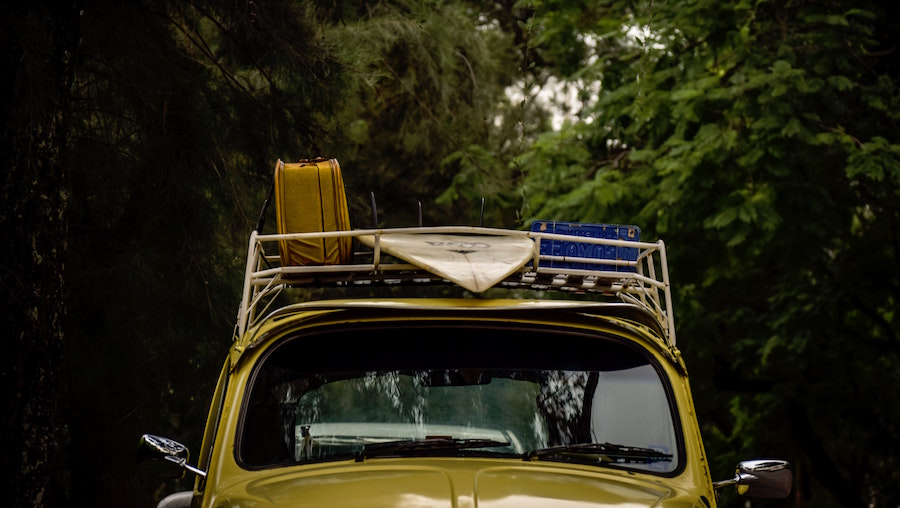
Summer is here and it’s road trip time for tens of thousands of BC residents. You’re car has been tuned up, you’ve mapped out the route(s), snacks have been packed, and your luggage and emergency kit have been tucked in the trunk. At this point it doesn’t seem like anything could go wrong. Just a heads up – have you taken a good look at what’s perched on your vehicle?
While racking things to the roof offers space saving convenience and allows you to bring recreational gear that doesn’t fit inside the vehicle, it poses a threat. Items can easily become untethered. Some may fall forward and obstruct your view, but most will fall behind and cause trailing vehicles to swerve and get into an accident. You may not even realize what happened until you get to your first rest stop to find you’re missing a surfboard or cooler. And not only is poorly secured cargo a hazard, it can get you fined if an officer deems your racking system to be insufficient. To keep from losing your racked load and being liable for an accident, follow the practical tips below.
5 Tips to Prevent Highway Accidents Due to Poorly Secured Things Falling from Your Vehicle
Follow the Rules in Your Vehicle’s Reference Manual
Your vehicle’s owner’s manual provides advice on cargo securement. Most newer models (year 2000+) have tie-down points for light items which the manual will identify. It will also provide warnings about securing items on the roof. These are not suggestions, but clearly stated directions. If you go against them your liability increases significantly. In addition to your owner’s manual, have a look at the specific load securement rules for BC. While most of the rules are in place for commercial operators, they provide helpful insight for personal drivers.
Choose Manufacturer Suggested Roof Racking Systems
Most automobile manufacturers have assembled lines of accessories for their makes and models. Among the accessories are roof racking systems. Some are for standard cargo, while others are specific to recreational equipment such as bicycles, kayaks, surfboards, and so forth. They are fabricated to fit the distinct contours of your vehicle and work cohesively with built-in tie-down ports and other appendages. Invest in these, versus generic systems that you find on Amazon or at some car accessory shop in the mall. Not only will they better secure your gear, it can reduce your liability if you have shown that you have abided by every reasonable safety measure.
When there is no manufacturer suggested system (as with older vehicles) do some extensive online research to find out what others recommend for a specific make or model. There are dedicated online forums and review sites that are managed and maintained by auto enthusiasts for you to reference.
Equipment Specific Racking Systems (when not offered by the auto manufacturer)
Even for new vehicles, there may not be a manufacturer-designed roof rack system for certain types of recreational equipment. Or, the system will be somewhat generic without adhering to the unique specifications of your gear. For example, the bicycle rack’s wheel holder may be a standard fit and not accommodate large-wheeled mountain bikes, or thin-wheeled touring bikes. Roof rack requirements for a shortboard surfboard are also vastly different for those of a longboard or paddle-board. The same is true for a single-person kayak and two-person kayak. Choose systems that are designed specifically for your equipment. Otherwise they can shift on the highway and come tumbling down.
If it Can be Contained, Contain It
For luggage loads such as clothes, kids’ toys, small recreational gear, and general road trip supplies be sure to use an enclosed rooftop cargo carrier. Popular brands include Thule and SportsRack. The general rule, is if it can be contained, contain it. Opt for hardshell rooftop carriers (versus textile) as they are less susceptible movement with the wind and precipitation moisture.
Inspect it at Every Stop
Clamps may be as secure as Fort Knox upon departure. However, you never know what will happen as you zip along the Coquihalla Highway, even under the allowable 100 km/hr speed limit. Be sure to check the integrity of your rooftop cargo and racking system at every pit stop that you make on your journey. In addition, if you or a passenger hears or feels (or think that you hear or feel) that something is shifting around up there, safely pull over at the next stop and perform an inspection.
Lastly, be sure to top off your automobile insurance with a more comprehensive policy before hitting the road this summer. Contact a broker at Park Insurance today for a review of your existing coverage.
